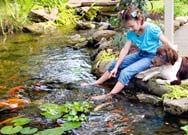
…and enjoy it
Living off-grid you really appreciate the value of water. Here are some suggestions, and anyone reading this is free to suggest other tips in the comments below or the forum.
Drip irrigation
A happy accident and a leaky spigot led to the discovery of drip irrigation. In an orchard, a leaky spigot was drip, drip, dripping water at the base of a tree. Over time, the tree getting the steady drip of water was doing better than the surrounding trees.
Over time, drip irrigation methods have evolved from commercial uses to the home landscape: vegetable and flower gardens and shrubs and trees
Conserving water is the chief benefit of drip irrigating: Less water is lost to evaporation; close to 100 percent of the water goes to the root zone
The trickle-down watering method also keeps plant leaves dry and less vulnerable to various fungal diseases
To test how much time is needed to put down 1 inch of water per week in any area, place a straight-sided can in the ground below the drip line and measure the depth of moisture after the drip system has been running for an hour
Installation can be a do-it-yourself project. A simple system requires a valve, backflow preventer, pressure regulator, filter, tubing adapter, drip tubing, emitters and an end cap. (Cue suggested using Google to find tutorials and other explanations on the Internet. One such site is https://irrigationtutorials.com .)
Rain garden
It isn’t a bog. It isn’t a pond. It doesn’t attract mosquitoes. It’s a shallow basin designed to catch a lot of water (often from a roof) and let it drain or percolate through the soil
In areas of the Midlands where the soil is like clay, the catch basin soil must be amended with compost, not sand or gravel, worked in deeply so that the soil is loose, not compacted.
Rain water should percolate slowly through the soil rather than sheeting off into the street and sewer
Rain gardens can range in size from 100 square feet, or 10-feet wide by 10 feet long, to 300 square feet. The gardens are shallow, 4 to 8 inches deep, and should drain completely within 48 hours.
Rain barrel
This is the solution if you don’t have room for a rain garden. A rain barrel — about $100 in wood or plastic and in various sizes, colors and styles — collects rain from the roof. A downspout diverter directs the water to the barrel
The captured water is high in micronutrients and good for plants. Rain is naturally soft water , without chlorine, fluoride and other chemicals
The water may be contaminated by leaves, bird droppings and dust — and unsafe to drink — but plants will thrive on it
If you have copper or zinc strips running across a cedar shake roof, that rainwater should not be diverted to a pond that has fish
Some roofs, such as old tar and gravel or old asbestos shingles create too much contamination for rainwater harvesting. Treated cedar shakes aren’t recommended either for water harvesting
For every inch of rain that falls on a 1,000-square-foot roof area, expect to collect about 600 gallons of rainwater.
Rooftop gardens
Well accepted in Europe, as it once was in the United States when settlers were building sodhouses on the prairie
Now the idea has followers among those who would reduce their reliance on air conditioning. Rooftop plants have a cooling effect on the roof
The roof can be flat or angled and reinforced to support plants, plant materials (soil-less mixes) and rainwater. Most applications call for a rubber base layer to keep out moisture
Sedum is the plant typically seen on rooftops, but options include native grasses such as sideoats grama, prairie dropseed and blue grama grass.